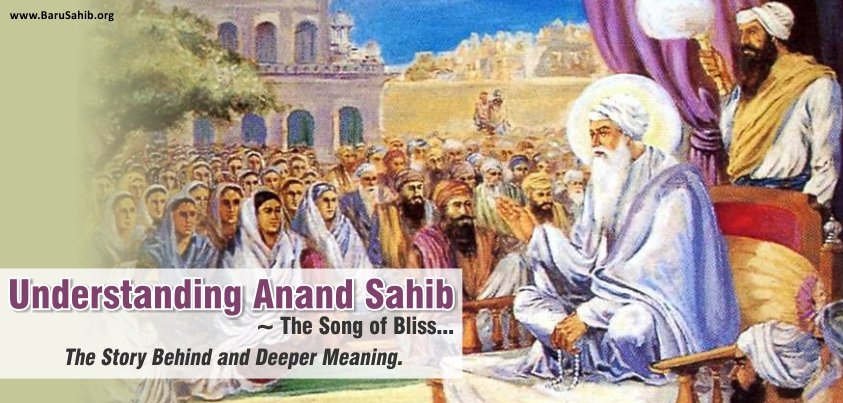Banda’s original name was Lachhman Dev. He was born in Kartik 1727 Bikrami Samvat, October-November 1670, four years after the birth of Guru Gobind singh. He belonged either to Kashmir or Punjab. He was a Rajput cultivator. By the time he was just turned 20, his astonishing mind was set on its task. He had a reputation of being a great hunter. One day he killed a doe which immediately delivered itself of two cubs which expired in his presence. The sight shocked him. He renounced worldly life and became a bairagi sadhu or a wandering hermit and ultimately settled at Nander on the banks of river Godavari in Maharashtra. He won great fame as a sorcerer under the name of Madhodas and commanded thousands of followers.
Guru Gobind Singh went to his hermitage. Madhodas was away. The Guru ordered his disciples to kill a few goats of the Bairagi and cook meat there and then. The matter was reported to Bairagi. The Guru asked him who he was. Madhodas replied, he was Banda or Guru’s slave. The Guru inquired, if he knew whom he was talking to. He said he was none other than Guru Gobind Singh. At that time Banda was 38 years old and Guru ji 42. The Guru encouraged him to give up his present way of living and resume the duties of a real Rajput. In few days the Guru held a durbar, conferred the title of Banda Bahadur on him and appointed him his military lieutenant to punish the Governor of Sarhind who had killed his two youngest sons, and was mainly responsible for the death of his two elder sons, his mother and thousands of Sikhs and Hindus. He was given a council of advisers of Five Sikhs who on their arrival in Punjab were to assure the Sikhs that Banda was Guru’s nominee and deputy to organize them in order to lead an expedition against Sarhind.
At a durbar held at Nander about the middle of September 1708, the Guru conferred the title of Bahadur on Banda and invested him with full political and military authority as his deputy to carry on the national struggle in the Punjab and to punish Wazir Khan of Sarhind and his supporters. He was supplied with a standard arrow and a drum as symbols of temporal authority. He was given an advisory council of five devoted Khalsa: Baj Singh, a descendant of the family of third Guru, Amar Das, his brother Ram Singh, Binod singh, who descended from Guru Angad Dev second Guru, his son Kahan singh and Fateh Singh. Twenty five soldiers were given to him as his bodyguard. A prescript called Hukumnamah or a letter of authority in the handwriting of the Guru instructing Sikhs to join Banda Bahadur in his national war against Mughal tyranny was provided. As an insignia of his temporal authority invested in him, Guru gave Banda Bahadur his own sword, green bow and Five arrows from his quiver. Three hundred Sikh cavaliers in battle array accompanied Banda to a distance of eight kilometers to give him final send off.
Torture and execution of Banda Bahadur by Mughals
Banda Singh’s rule, though short-lived, had a far-reaching impact on the history of the Punjab. With it began the decay of Mughal authority and the demolition of the feudal system of society it had created. Banda Singh increasing influence roused the ire of the Mughal emperor, Bahadur Shah, who journeyed northwards from Deccan to punish Sikhs. Instructions were issued to the governors of Delhi and Oudh and other Mughal officers to march towards Punjab. Prohibitory laws against Sikhs were passed. Fearing that some Sikhs might not have smuggled themselves into the royal camp disguised as Hindus, Bahadur Shah ordered all Hindus employed of imperial forces to shave off their beards. Emperor Bahadur Shah’s order, issued on December 10, 1710 was a general warrant for the faujdars to “kill the worshippers of Nanak, i.e. Sikhs, wherever they are found. (Nanak Prastan ra Har ja kih bayaband baqatl rasanand)” Banda was chased out of Every corner of Punjab and he took refuge in the Shivalik hills.
He got married to daughter of one of the hill chiefs and it was few years before Mughals could trace him down . He again started his campaigns against Mughals and came out of hills to the plains of Punjab. But was overwhelmed by the superior numbers of Mughal forces. As reported to emperor Bahadur Shah on April 28th 1711, (Akhbarat-i-darbar-i-mualla) , “The wretched Nanak-worshipper (Banda Singh) had his camp in the town of Kalanaur (District Gurdaspur). He has promised and proclaimed: “I do not oppress the Muslims.” Any muslim who approaches him, he fixes a daily allowance and wage, and looks after him. He has permitted them to recite khutba and namaz. As such five thousand Muslim have gathered round him. siege_Picture
The massive imperial force drove the Sikhs from Sirhind and other places to take shelter in the fort of Lohgarh in the hilly region. “It is impossible for me,” says Khafi Khan a muslim historian of that time, “to describe the fight which followed. The Sikhs in ther faqir’s dress struck terror into the hearts of the royal troops. The number of casualties among the latter was so large that for a time it appeared as if they were going to lose.”
Further reinforcements arrived and sixty thousand horse and foot closely invested Banda’s hill retreat. For want of provisions, Sikhs were reduced to rigorous straits. They killed their horses for food, and when they could stand up to the enemy no longer, they made desperate nightly sally to escape into the hills of Nahan. Banda was far from vanquished. A hukamnamah, issued by him to his followers within a fortnight of his leaving the fort of Lohgarh, showed the spirit which swayed the Sikhs during those arduous times. The following is an English version of Banda Singh’s letter.
Deg O Teg O Fateh o nusrat bedirang
Yaft Az Nanak Guru Gobind Singh
The kettle and the sword (Symbols of charity and power), victory and blessing have been obtained from Guru Nanak-Gobind Singh. God is one! Victory to the Presence!! This is the order of Sri Sachcha Sahib (The great master) to the entire Khalsa. The Guru will protect you. Call upon the Guru’s name. Your lives will be fruitful!. You are the Khalsa of the great immortal God. On seeing this letter, repair to the presence, wearing five arms. Observe the rules of conduct laid down for the Khalsa. Do not use Bhang, tobocco, Poppy, wine, or any other intoxicant…Commit no theft or adultery. We have brought Satyug (the golden age) Love one another. This is my wish. He who lives according to the rules of Khalsa shall be saved by the Guru.
Torture and execution of Banda Bahadur by Mughals
Banda Singh’s rule, though short-lived, had a far-reaching impact on the history of the Punjab. With it began the decay of Mughal authority and the demolition of the feudal system of society it had created. Banda Singh increasing influence roused the ire of the Mughal emperor, Bahadur Shah, who journeyed northwards from Deccan to punish Sikhs. Instructions were issued to the governors of Delhi and Oudh and other Mughal officers to march towards Punjab. Prohibitory laws against Sikhs were passed. Fearing that some Sikhs might not have smuggled themselves into the royal camp disguised as Hindus, Bahadur Shah ordered all Hindus employed of imperial forces to shave off their beards. Emperor Bahadur Shah’s order, issued on December 10, 1710 was a general warrant for the faujdars to “kill the worshippers of Nanak, i.e. Sikhs, wherever they are found. (Nanak Prastan ra Har ja kih bayaband baqatl rasanand)” Banda was chased out of Every corner of Punjab and he took refuge in the Shivalik hills.
He got married to daughter of one of the hill chiefs and it was few years before Mughals could trace him down . He again started his campaigns against Mughals and came out of hills to the plains of Punjab. But was overwhelmed by the superior numbers of Mughal forces. As reported to emperor Bahadur Shah on April 28th 1711, (Akhbarat-i-darbar-i-mualla) , “The wretched Nanak-worshipper (Banda Singh) had his camp in the town of Kalanaur (District Gurdaspur). He has promised and proclaimed: “I do not oppress the Muslims.” Any muslim who approaches him, he fixes a daily allowance and wage, and looks after him. He has permitted them to recite khutba and namaz. As such five thousand Muslim have gathered round him. siege_Picture
The massive imperial force drove the Sikhs from Sirhind and other places to take shelter in the fort of Lohgarh in the hilly region. “It is impossible for me,” says Khafi Khan a muslim historian of that time, “to describe the fight which followed. The Sikhs in ther faqir’s dress struck terror into the hearts of the royal troops. The number of casualties among the latter was so large that for a time it appeared as if they were going to lose.”
Further reinforcements arrived and sixty thousand horse and foot closely invested Banda’s hill retreat. For want of provisions, Sikhs were reduced to rigorous straits. They killed their horses for food, and when they could stand up to the enemy no longer, they made desperate nightly sally to escape into the hills of Nahan. Banda was far from vanquished. A hukamnamah, issued by him to his followers within a fortnight of his leaving the fort of Lohgarh, showed the spirit which swayed the Sikhs during those arduous times. The following is an English version of Banda Singh’s letter.
Deg O Teg O Fateh o nusrat bedirang
Yaft Az Nanak Guru Gobind Singh
The kettle and the sword (Symbols of charity and power), victory and blessing have been obtained from Guru Nanak-Gobind Singh. God is one! Victory to the Presence!! This is the order of Sri Sachcha Sahib (The great master) to the entire Khalsa. The Guru will protect you. Call upon the Guru’s name. Your lives will be fruitful!. You are the Khalsa of the great immortal God. On seeing this letter, repair to the presence, wearing five arms. Observe the rules of conduct laid down for the Khalsa. Do not use Bhang, tobocco, Poppy, wine, or any other intoxicant…Commit no theft or adultery. We have brought Satyug (the golden age) Love one another. This is my wish. He who lives according to the rules of Khalsa shall be saved by the Guru.
On June 9th , came the turn of Banda Singh. Harshest torments had been reserved for him. His eyes were pulled out and his hands and feet chopped off. His flesh was torn with red hot pincers. The end came, mercifully for him with the executioner’s axe falling on his neck. With his end Sikhism did not die on the contrary Sikhism came out strong and the torch of Banda Singh Bahadur was carried with new Warriors like Nawab Kapur Singh Virk, Sardar Budh Singh, Sardar Charat Singh, Baba Deep Singh ji Shaheed, Sardar Jassa Singh ji Ahluwalia, Maharaja Ranjit Singh, Hari singh Bhangi, etc.
Manas ki jaal sabhai ekai pehchaanbo is the Guru Gobind Singh’s message. which emphatically states “men may call themselves Hindus, Muslims, Emams and Shaffies, but I see them all belonging to one race mankind.” Guru Gobind Singh had given Banda specific orders to punish those who had persecuted good saints like Pir Budhu Shah. He had not mentioned any revenge on those who had executed his own young boys at Sirhind. Hc had expected Bahadur Shah to fulfil his promise to punish those who had committed atrocitics on good men, but had parted company from the Emperor completely disappointed. Banda Singh was then taught to bring to reality the Guru’s own dream!
Source – http://www.sikh-history.com/sikhhist/warriors/banda.html
Share the Historic story through the Social Buttons listed here!











